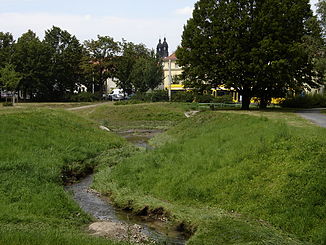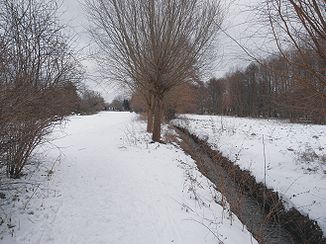Kaitzbach
| Kaitzbach | ||
|
The Kaitzbach between the lateral retention basins of the Hugo Bürkner Park above Strehlen |
||
| Data | ||
| location | Dresden , Saxony , Germany | |
| River system | Elbe | |
| Drain over | Elbe → North Sea | |
| source | above the baths of Kleinnaundorf 50 ° 59 ′ 48 ″ N , 13 ° 41 ′ 4 ″ E |
|
| muzzle | on the terrace bank below the eastern end of the Brühl Terrace in the Elbe (no longer visible today) 51 ° 3 ′ 13 ″ N , 13 ° 44 ′ 47 ″ E
|
|
| length | 11.9 km | |
| Drain |
MQ |
35 l / s |
|
Sandstone bridge in the center of the village of Mockritz |
||
|
Kaitzbach in Mockritz |
||
The Kaitzbach , formerly also Kaiditzbach , is a left tributary of the Elbe in the south of Dresden . Its length is currently 11.92 kilometers, the average flow rate is around 35 liters per second. It was named after the village and current Dresden district of Kaitz .
course






The Kaitzbach rises above the baths of Kleinnaundorf on the west side of the Horkenberg , flows through the Kaitzgrund and Kaitz (here tributary of the Zschaukebach ) to Mockritz (here tributary of the Nöthnitzbach ), from there through the Dresden district of Strehlen . Parts of its course are laid underground, for example at Strehlen train station . Then it reaches the Great Garden in this form , where it branches out. Since 2008, part of the Kaitzbach has been exposed and flood protection has been improved. The Kaitzbach used to flow into the sewer system. Now the stream flows visibly in the Great Garden and seeps away at the Rodelbergbrunnen. The old course is directed south along the park side of the Dresden Zoo , the other branch feeds the Carolasee and the Neuteich connected to it in the northern part of the Great Garden. As the Kaitzbach flood ditch , the canal-like waterway leaves the Great Garden on Stübelallee, where it is drained underground in a northerly direction.
The Kaitzbach flows through the Bürgerwiese park in the Pirnaische Vorstadt , where it temporarily fed the water systems in the park of the no longer preserved Prinzen-Palais . In the Bürgerwiese, a small watercourse flowed into the Kaitzbach, which led from its branches from the Elbe valley slope on the Zellescher Weg below Räcknitz .
At the northwest end of the Bürgerwiese Kaitzbach fed the artificial and 1849 filled- Jüdenteich today grains monument and resulted in the former moat of the old city. In centuries past it branched out like a canal in the area of the medieval city and, in addition to some pipelines (water from the Weißeritz and the Holy Born ), was the main water supply for Dresden.
Not far from the town hall and at the former Brühl Garden , the course is only underground today. Near the synagogue , the course is indicated by glass elements that are illuminated at night. The Kaitzbach flows into the Elbe at the Terrassenufer below the eastern end of the Brühl Terrace . It is one of the few streams that flow into the Elbe , whose course is initially parallel to the Elbe and also in the Kaitzgrund to the southeast, i.e. upstream.
On an initiative of the Dresden Secession 89 , the WasserKunstWeg Mnemosyne was created from 2000 , which artistically accompanies the Kaitzbach on its inner-city course, which is no longer visible. Christa Donner's nine “Musensteine” (after the daughters of Mnemosyne ) represent a specialty , which not only gave the WasserKunstWeg its name, but are distributed from the Kaitzbach spring to the city center Rathenauplatz near the mouth.
history
An early Slavic settlement of the Kaitzgrund (below Coschütz ) is proven from excavation finds. The origin of the village Kaitz is a Slavic round hamlet . In the time around 1200 there were about five water mills on the then also called Grundbach (especially the upper reaches of the creek), some of which lasted until the middle of the 20th century. The first mill on the watercourse and still belonging to Cunnersdorf was the Ehrlichsmühle , later named after the use of the estate, bone or cake mill . The other three mills were all on Kaitzer Corridor. The middle one was the Adamsmühle , which was also called Claus-, Walters- or Herrmannsmühle after its later owners. The next one further down the valley was the Köhler or Zschachlitz mill . In 1955 this had to give way to the creation of the overburden dump of the Gitterseer mining industry . In the further course of the brook (residents of the Kaitzgrund say "the brook"), at the former confluence with the Zschaukebach in Altkaitz , is the Grundmühle, later Hofemühle . At the beginning of the 17th century, the salt treasurer Walter Lehmann was its owner. The latter is one of the nucleus of the Amtlehngut and thus the village of Kaitz and on the Altkaitz 6 property to a large extent. Finally, on the Mockritzer corridor , below the Münzteich pond, there was the Mockritzer mill , later a restaurant (Münzteichweg 23). Another mill on the Kaitzbach - the Strehlener Mühle - was in Strehlen (Dohnaer / Mockritzer Straße). The watermill at Dohnaer Straße 18 (Dresden-Strehlen) was converted into a steam mill in 1870 .
From 1682 the Kaitzbach fed a large gondola basin in the Blüherpark for a century and was diverted through this area between 1783 and the late 1920s. During the Battle of Dresden in 1813, the Kaitzgrund, with its slopes and surrounding heights, was one of the most important strategic locations and, for this reason, was fought over several times from August to October of that year. In the middle of the 19th century, the Kaitzgrund developed into a popular local recreation area for Dresden residents. This led to a large number of excursion restaurants.
The end of this use was initiated by the city of Dresden, which dumped a garbage dump on the slope north of Kaitz at the beginning of the 20th century. As a result of the uranium mining carried out in Coschütz / Gittersee in the 1950s , the Kaitzgrund between Cunnersdorf and Coschütz was filled in by one of two (radioactively contaminated) spoil heaps (initially mud ponds ). The Kaitzbach, which was temporarily contaminated, was passed through an 800 m long tunnel on the southern slope under the dump. Here the Kaitzbach still absorbs the water volumes of 8 to 12 liters per second that arise as a result of the mine drainage of the Gitterseer shafts. The Carolasee gondola pond in the Great Garden is fed by the Kaitzbach. At the beginning of the 1990s this pond was cleared of radioactively contaminated sludge from the Kaitzbach in a complex operation.
- Kaitzbach on old maps
Jüdenteich and Kaitzbach around 1759 on the city wall near the Kreuzkirche (map southward )
"In Dresden , my parents rented the first floor of the Tepmannsche House, which was located in front of the Seetore in" Halben Gasse ". [...] this bore her name with the fact, because she only enjoyed a row of houses that were vacant because of that View of the gardens opposite. […] From the courtyard one stepped into the garden, which was cut through by the Katzbach , a narrow but deep water. On this side of the water there was an extensive vegetable being, on the other side meadows, fruit trees and bushes. [...] next to it, a little gate led out into the field and to the heights of Räcknitz and Plauen . "
Flood
The lower layers of the Kaitzgrund were always considered to be at risk of flooding. The citizens of Kaitz and Altmockritz used to expect a major flood every seven to ten years with a flow rate of 750 to 1500 liters per second. There was one of the larger ones in August 1984, caused by a downpour and the large rapeseed field operated by the LPG at the time on the slope south of Kaitz in the direction of Nöthnitz with a high runoff value, as the drills were smooth. In the gardens on the Kaitzbach, the water was waist-high and, after it had drained off, the mud was 10 to 15 centimeters. After another two weeks, the flowering rape was three feet high.
During the August floods in 2002 , the Kaitzbach overflowed its banks at a maximum flow rate of 2000 liters per second and caused severe damage in Altmockritz and Strehlen ( high water mark on the Altmockritz property 2). At that time it caused a major flood in the Great Garden. For this reason, measures for flood protection have been taken in the course of the construction of the federal motorway 17 since 2002 . This included the cleaning, fortification and partial relocation of the stream bed, the addition of bank planting and the creation of overflow and stilling basins and planted areas in the course of the stream.
Two further sections of the subterranean areas of the brook were re-opened in 2006 in the Strehlen district. The section, which ends near the S-Bahn stop in Strehlen, has been integrated into the landscape (newly built bridge, new stilling basin, natural stone fortifications on the banks with railings) to complement the local recreation zone of this district.
literature
- History Association Kaitz eV (Ed.): The Kaitzbach from the source to Kaitz . In: Kaitz 1206-2006, Eine Chronik .
- History Association Kaitz eV (Ed.): Pollution of the Kaitzbach through mining and uranium ore processing .
- Kai Temple: Villages in Dresden from A - Z . Hille, Dresden 2007
- State capital Dresden: City map 2007 - Surface waters .
- Günter Albrecht, Frank Frenzel: The Kaitzbach in Dresden: A way with the water. Hille, Dresden 2002, ISBN 3-932858-63-8 .
- Frank Frenzel, Silke Reichmann : Bach pictures and other ideas. Results and perspectives of planning activities along the Kaitzbach . In: WasserKultur. Urbanity-Technology-Ecology Journal of the BMFT research project WasserKultur, No. 5/6, Kassel 1996, 35–39.
Web links
- Kaitzbach water profile (PDF; 6.3 MB), City of Dresden, 2012
Individual evidence
- ^ H. Aster: Floor plan of Dresden in 1778, with the newly projected and built field fortifications . copied 1842. In: Otto Richter : Atlas for the history of Dresden 1521–1898 . Dresden 1898
- ^ Gerke, Rat zu Dresden, Vermessungsamt (Ed.): Plan von Dresden 1912 . 1912
- ↑ H. Ebert, H. Grahmann, K. Pietzsch : Explanations of the geological map of Saxony on a scale of 1:25,000 . No. 66 sheet Dresden. Ed .: Saxon Ministry of Finance. 3. Edition. Leipzig 1934, p. 128 .
- ^ Behrisch (recording), Julius Keyl (engraving): Plan of Dresden . Royal Police Direction to Dresden (Ed.), Dresden 1863
- ^ Friedrich Christian August Hasse: Dresden and the surrounding area to Elsterwerda, Bautzen, Herrnhut, Rumburg, Aussig, Töplitz, Freyberg and Hubertsburg. First part . Second increased edition. Dresden 1804, p. 86
- ^ State capital Dresden, Office for Culture and Monument Protection (Ed.): MNEMOSYNE: WasserKunstWeg der Dresdner Sezession '89 e. V. Dresden 2009 ( PDF; 2.1 MB ( memento from January 9, 2015 in the Internet Archive )).
- ↑ a b c d see Dresden-Mühlen.de ( Memento from November 5, 2015 in the web archive archive.today )
- ^ Pencil drawing by Max Eckardt , Staatliche Kunstsammlungen Dresden .
- ↑ Wilhelm von Kügelgen: Memories of the youth of an old man . Köhler & Amelang, Leipzig 1924.




